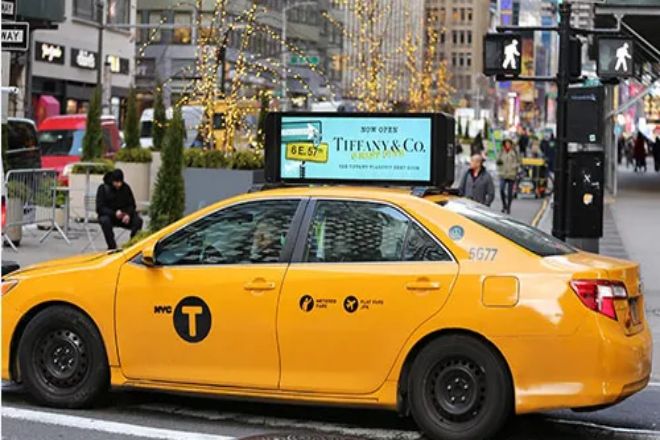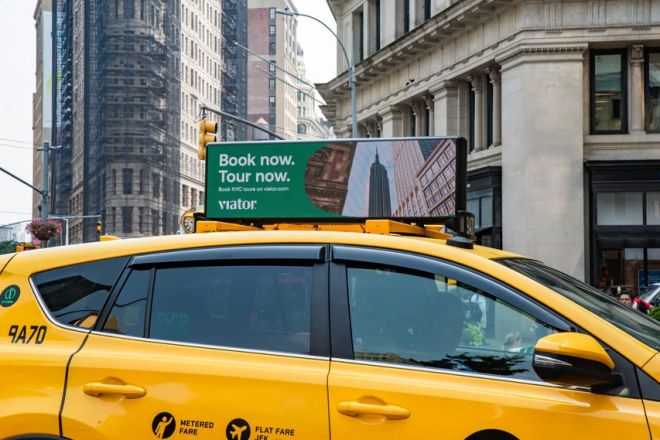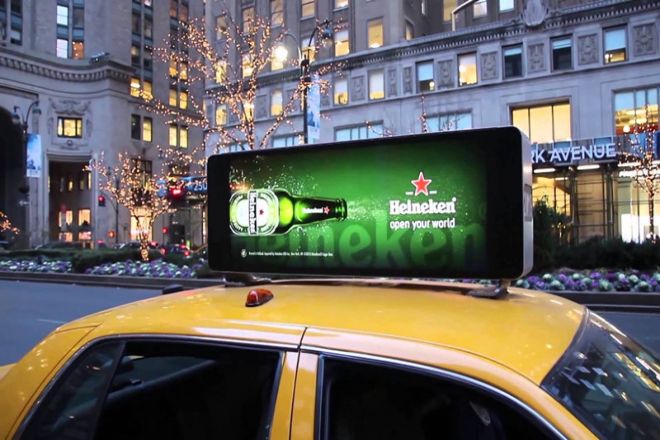Introduction

On the busy streets of modern cities, taxis, as an important part of urban transportation, not only carry the travel needs of passengers but also become part of the urban flow scenery. Among them, taxi LED displays play an increasingly important role in the urban transportation and advertising market due to their unique viewing angles, high visibility, and mobility.
These displays are not only windows through which passengers can obtain real-time information but also an important platform for city image display and advertising promotion. However, with the continuous advancement of technology and the changing market, taxi LED displays are also facing many challenges and development opportunities.
1. Display technology
- High-resolution, high-contrast taxi LED displays:
With the continuous advancement of display technology, the resolution and contrast of taxi LED displays have been significantly improved.
The high resolution makes the advertising content clearer and more detailed, while the high contrast ratio ensures that the content on the display screen can maintain sufficient visibility under different lighting conditions. This not only improves the visual experience of passengers but also enhances the attractiveness of advertising content.
- Flexible taxi LED displays:
The application of flexible LED displays brings more possibilities to taxi LED displays. Compared with traditional rigid displays, flexible displays can better adapt to the roof curves of different models and achieve a seamless fit. This not only improves the aesthetics of the display but also enhances its durability and impact resistance.
- Transparent taxi LED displays:
The potential of a transparent LED display lies in its ability to display content and transmit light at the same time. This means that during the day or in well-lit conditions, passengers can see the scenery outside the car through the LED display on the roof.
At night or in low-light conditions, the display can display advertising content or other information. This dual function will give the transparent taxi LED displays broad application prospects in the future.
1). Intelligence and Internet
- Application of Internet of Things technology in taxi LED displays management:
Through Internet of Things technology, taxi LED displays can realize functions such as remote monitoring, data collection, and analysis. This not only improves display management efficiency but also enables advertisers to more accurately evaluate advertising effectiveness and optimize it.
- Optimization of artificial intelligence algorithms in content push and advertising:
Using artificial intelligence algorithms, taxi LED displays can push personalized advertising content based on passengers’ travel habits, preferences, location information, and other factors. This not only increases the click-through rate and conversion rate of advertisements but also enhances passengers’ travel experience.
- Connection and interaction functions with passengers’ smartphones:
Through Bluetooth, Wi-Fi, and other technologies, the taxi LED displays can connect and interact with passengers’ smartphones. Passengers can view advertising details on the display screen, participate in interactive games, or enjoy other value-added services through their mobile phones. This interactive feature not only increases passenger engagement but also provides advertisers with more marketing tools.
2). Energy saving and environmental protection
- Innovation and application of LED energy-saving technology:
With the continuous development of LED energy-saving technology, the energy consumption of taxi LED displays has been significantly reduced. The new generation of LED chips has higher luminous efficiency and lower power consumption, allowing the display to greatly reduce energy consumption while maintaining high brightness and high definition.
- The use of environmentally friendly materials in the manufacturing of taxi LED displays:
In order to reduce environmental pollution and resource waste, more and more manufacturers are beginning to use environmentally friendly materials to manufacture taxi LED displays. Not only are these materials more recyclable and degradable, but they also reduce pollutant emissions during the manufacturing process.
- Research and practice of energy recovery and reuse technology:
In order to further improve energy efficiency, some advanced manufacturers are researching and practicing energy recovery and reuse technology.
For example, they collect the heat or light energy generated by the display during use and convert it into electricity or other forms of energy for reuse. This technology not only reduces energy consumption and operating costs but also helps promote green travel and sustainable development.
2 . Traffic management application expansion

1). Real-time traffic information display
- Release of real-time traffic conditions and traffic congestion information:
The taxi LED displays can display the traffic conditions of the current road section in real-time, including traffic conditions, congestion levels, and other information, helping passengers understand the road conditions ahead and plan their travel routes reasonably.
- Integration and display of public transportation transfer information:
By integrating public transportation route and timetable information, taxi LED displays can display key information such as transfer stations, transfer routes, and estimated arrival times, providing passengers with convenient Transfer instructions.
- Traffic diversion and guidance in emergencies:
In emergencies, such as traffic accidents, road construction, etc., taxi LED displays can quickly release traffic diversion and guidance information, guide vehicles to avoid congested road sections, and reduce traffic congestion and delays.
2). Advertising and Business Promotion
- Optimization of advertising strategies and effects:
By collecting and analyzing passengers’ travel data, advertisers can formulate more precise advertising strategies and improve advertising click-through rates and conversion rates. At the same time, the LED taxi screen on the roof can monitor the advertising effect in real-time and make adjustments and optimizations based on the data.
- Real-time update and push of merchant preferential information:
Merchants can publish preferential information and promotions in real-time through the taxi LED displays to attract passengers’ attention and participation. This real-time update method makes advertising content more timely and attractive.
- Establishment of passenger interaction and feedback mechanism:
Passengers can interact with advertising content and provide feedback by scanning QR codes or participating in interactive games. This interactive approach not only increases passenger engagement but also provides advertisers with valuable user feedback.
3). Safety tips and emergency warnings
- Release of safe driving reminder information:
The LED taxi screen on the roof can release safe driving reminder information, such as speed limit, no lane changes, attention to pedestrians, etc., to remind drivers to pay attention to traffic safety.
- Early warning and evacuation guidance in emergencies:
In emergencies, such as fires, earthquakes, etc., the taxi LED displays can quickly issue early warning information and evacuation guidance to help passengers quickly evacuate dangerous areas.
- Linkage and collaboration with the traffic management department:
Through linkage and collaboration with the traffic management department, the taxi LED displays can receive and issue instructions and information from the traffic management department, assisting the traffic management department in traffic diversion and control. This linkage method can improve the efficiency and accuracy of traffic management and provide a strong guarantee for urban traffic safety.
3. Market trends and business models
1). Market size and growth forecast
- The current status and trends of the domestic and foreign taxi LED display markets:
Currently, the domestic and foreign taxi LED display markets are showing a steady growth trend.
Foreign markets have relatively high market maturity due to their early technology start, while the domestic market has benefited from the acceleration of urbanization and the improvement of transportation infrastructure, and the market size is also expanding.
According to industry research reports, it is expected that the global LED display market will reach billions of dollars by 2028, of which the taxi LED displays market will occupy an important share.
- The growth potential and space of the taxi LED displays market:
With the increasingly heavy urban traffic and the continuous expansion of the advertising market, the taxi LED displays market has huge growth potential. On the one hand, taxis, as an important part of urban transportation, have strong mobility and high exposure, making rooftop LED displays an important choice for advertisers.
On the other hand, with the advancement of technology and the reduction of costs, taxis have become an important choice for advertisers. The cost-effectiveness of roof-mounted LED displays will continue to improve, further driving market growth.
2). Business model innovation
- Advertising delivery model based on big data and cloud computing:
With the continuous development of big data and cloud computing technology, the advertising delivery model of taxi LED displays is also constantly innovating.
By collecting and analyzing big data such as passengers’ travel data, location information, and interest preferences, advertisers can formulate more precise advertising strategies and improve advertising click-through rates and conversion rates.
At the same time, the application of cloud computing technology also makes the distribution and update of advertising content more efficient and convenient.
- Sharing of taxi LED displays resources under the sharing economy model:
Under the sharing economy model, taxi LED display resources can be shared and effectively utilized. For example, advertisers can place advertising content on multiple taxi LED displays through leasing or sharing, achieving rapid dissemination and wide coverage of advertising.
This model not only reduces advertising costs but also improves resource utilization efficiency.
- Cross-industry cooperation and industry chain integration:
The development of the taxi LED displays market requires cross-industry cooperation and industry chain integration. For example, advertisers can cooperate with car manufacturers, taxi companies, data service providers, etc., to jointly promote market development and innovation.
At the same time, cooperation and win-win results between upstream and downstream enterprises in the industrial chain are also important factors in promoting market development.
3). Market competition and cooperation
- Analysis and comparison of major domestic and foreign competitors:
In both domestic and foreign markets, there are a number of competitive rooftop LED taxi screen manufacturers and service providers. There are differences and competition between these enterprises in terms of technical level, product quality, market share, etc.
By comparing and analyzing the strengths and weaknesses of these companies, we can better understand the market dynamics and competitive situation.
- Cooperation and win-win among enterprises upstream and downstream of the industrial chain:
There is a relationship of cooperation and win-win among enterprises upstream and downstream of the industrial chain. For example, chip manufacturers can provide high-quality LED chips to display manufacturers; display manufacturers can provide taxi LED display advertising services to advertisers.
Advertisers can use the services of display manufacturers to Advertise content placed on multiple taxi LED displays. This cooperation model can promote the common development of upstream and downstream enterprises in the industrial chain.
- Expansion and cooperation in the international market:
With the acceleration of globalization and the continuous development of international trade, the taxi LED displays market is also facing opportunities for expansion and cooperation in the international market.
Through docking and cooperation with the international market, we can introduce advanced technology and management experience, and improve product quality and service levels; at the same time, we can also promote domestic products and services to the international market and expand overseas market share.
4. Regulations, policies, and ethical challenges

1). Regulations and policy restrictions
- Domestic and foreign regulations and policies related to taxi LED displays:
Countries have different regulations and policies for vehicle-mounted LED displays, but they generally focus on aspects such as product quality, traffic safety, and advertising. For example, some European countries have special traffic regulations that specify the size, brightness, color, etc., of vehicle-mounted LED displays.
- Regulations and requirements for advertising delivery and content management:
Advertising must comply with relevant laws and regulations, such as the Advertising Law of the People’s Republic of China. The content must be true, legal, and healthy and must not contain false, exaggerated, or misleading information.
In terms of content management, it is necessary to ensure that advertising content complies with social morality and ethical standards to avoid adverse effects on passengers.
2). Privacy protection and data security
- Application of data security and encryption technology:
With the advent of the digital age, data security and privacy protection have become important issues. For taxi LED displays, the protection of user data should be strengthened, and data encryption technology should be used to ensure data transmission security.
At the same time, a complete data management system must be established to prevent data leakage and abuse.
3). Ethical challenges
- Ethical standards for advertising and content screening:
During the ad placement and content screening process, ethical and moral standards should be observed, and content that may cause controversy or discomfort should be avoided.
At the same time, passengers’ acceptance and comfort should be fully considered to ensure that advertising content will not have a negative impact on passengers.
- Research on the impact on passenger psychology and behavior:
As an advertising carrier for urban mobility, the LED taxi screen on the roof may have a certain impact on the psychology and behavior of passengers.
Therefore, relevant research is needed to understand passengers’ reactions and acceptance of advertising content in order to better formulate advertising strategies and content screening criteria.
Conclusion
Looking to the future, LED taxi screens on taxi roofs will continue to evolve in terms of technological innovation, application expansion, and user experience.
With the in-depth application of 5G, Internet of Things, artificial intelligence, and other technologies, displays will achieve more efficient remote monitoring, data collection and analysis, and more accurate personalized services.
Finally, if you want to know more about taxi LED displays, please get in touch with us.
